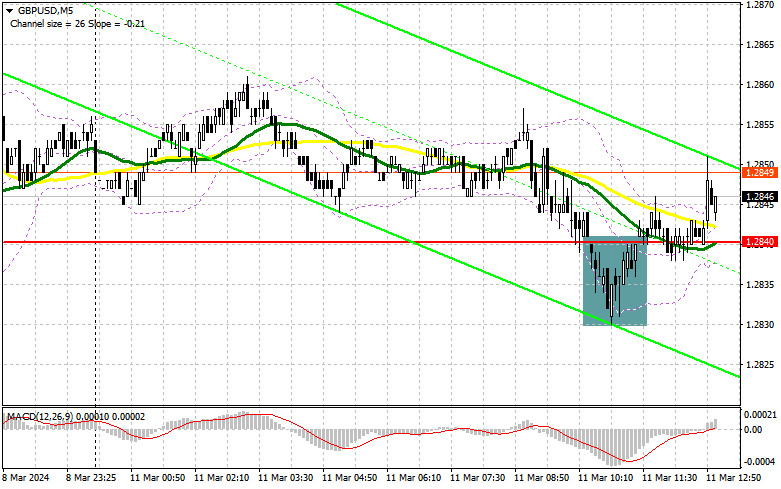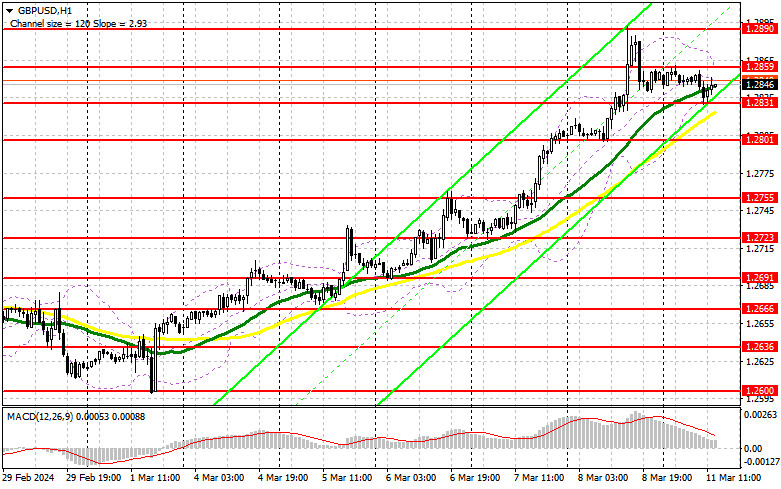
In my morning forecast, I focused on the level of 1.2840 and planned to make entry decisions based on it. Let's look at the 5-minute chart and analyze what happened there. The decline and the formation of a false breakout allowed us to get a suitable signal to buy the pound, which resulted in the pair's growth by only 10 points, after which all market activity subsided. The technical picture was revised for the second half of the day.

To open long positions on GBP/USD:
In the second half of the day, there is no statistical data, so one should not expect too many active actions from either buyers or sellers. In the case of a pair decline, I prefer to act after a decrease and the formation of a false breakout around the new support at 1.2831, formed at the end of the first half of the day. This will provide a suitable entry point for long positions with the expectation of the continuation of the bullish trend with the prospect of updating to 1.2859 – a new resistance where buyers will likely face serious problems. Breaking and consolidating above this range will strengthen demand for the pound and open the way to 1.2890, reinforcing the bullish positions. The ultimate target will be the maximum of 1.2923, where I plan to take profits. In the scenario of the pair's decline and the lack of activity from the bulls at 1.2831 in the second half of the day, and since the moving averages are also located there, the pound may weaken. In such a case, only a false breakout around the next support at 1.2801 will confirm the correct entry point into the market. I plan to buy GBP/USD immediately on the rebound from 1.2755, with the target of a correction of 30-35 points within the day.
To open short positions on GBP/USD:
The bears need to stay below 1.2859. A false breakout at this level in the case of the pair's rise will be an excellent confirmation of the sell signal, expecting a downward correction, leading to a move down to test 1.2831 – support where the moving averages, favoring buyers, intersect. Breaking and reverse testing from bottom to top of this range will deal another blow to the bullish positions, pushing the pair towards 1.2801, where significant buyers are expected to show up. The ultimate target will be the area of 1.2755, where profits will be taken. In the case of GBP/USD rising and the lack of activity at 1.2859 in the second half of the day, which seems to be the case, buyers will once again feel the strength for further development of the upward trend. In such a case, I will postpone sales until there is a false breakout at the level of 1.2890. If there is no downward movement, I will sell GBP/USD immediately on the rebound from 1.2923, but only counting on a pair correction down by 30-35 points within the day.


Indicator signals:
Moving averages:
Trading is conducted above the 30 and 50-day moving averages, indicating further pound growth.
Note: The author uses a 1-hour H1 chart for moving averages, which differs from the general definition of classic daily moving averages on a daily D1 chart.
Bollinger Bands:
In case of a decline, the lower boundary of the indicator at 1.2831 will act as support.
Description of indicators:
Moving Average (MA): Determines the current trend by smoothing volatility and noise. Period 50. Marked on the chart in yellow.Moving Average (MA): Determines the current trend by smoothing volatility and noise. Period 30. Marked on the chart in green.Moving Average Convergence/Divergence (MACD): Fast EMA period 12, Slow EMA period 26, SMA period 9.Bollinger Bands: bands representing the volatility and price levels above and below the moving average. Period 20.Non-commercial traders: speculators such as individual traders, hedge funds, and large institutions using the futures market for speculative purposes and meeting certain requirements.Long non-commercial positions represent the total number of long open positions held by non-commercial traders.Short non-commercial positions represent the total number of short open positions held by non-commercial traders.The total non-commercial net position is the difference between the short and long positions of non-commercial traders.